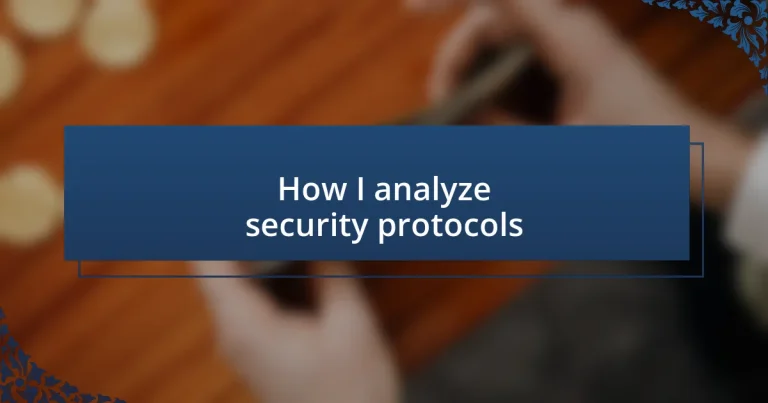Key takeaways:
- Security protocols are essential for protecting sensitive data online, ensuring confidentiality, integrity, and availability.
- Continuous analysis of security helps identify vulnerabilities and adapt to emerging threats, promoting a proactive security culture.
- Common vulnerabilities include weak authentication, outdated encryption, and improper error handling, which can lead to significant security breaches.
- Best practices for securing protocols include implementing strong authentication, keeping encryption standards up-to-date, and conducting regular audits.
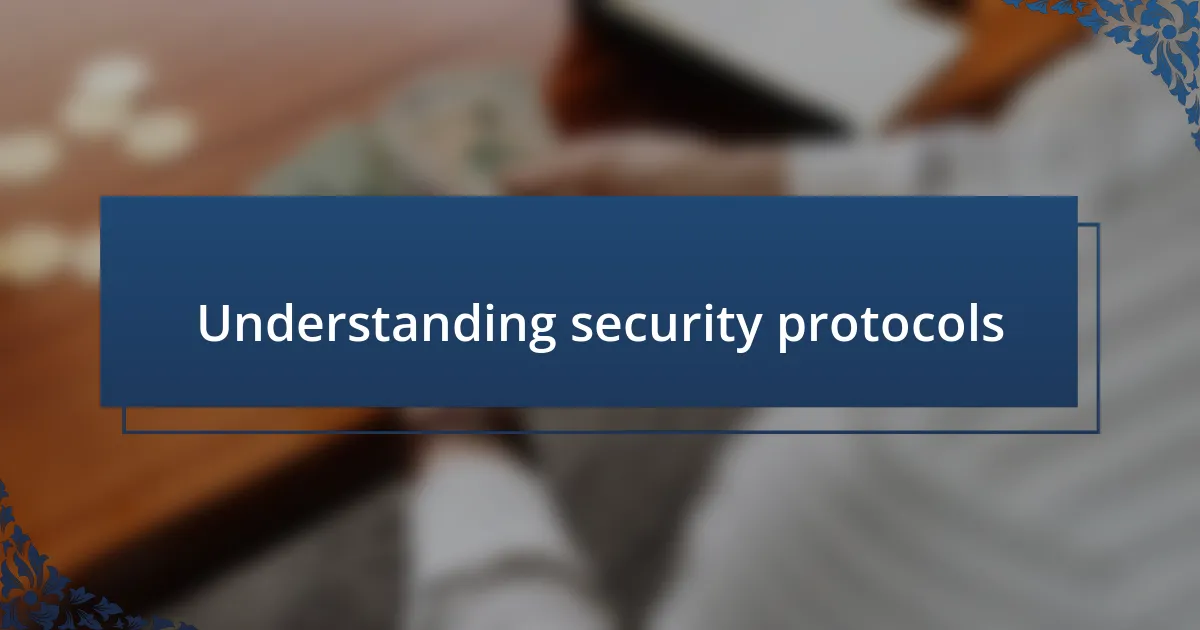
Understanding security protocols
When I first started delving into security protocols, I was struck by how they serve as the backbone of our digital interactions. Every time I send sensitive information online, whether it’s an email or a bank transaction, I rely on these protocols to protect my data from prying eyes. It made me wonder how many people really understand the importance of these unseen guardians in our daily online activities.
One key aspect of security protocols is their design to ensure confidentiality, integrity, and availability of data. For example, when I learned about SSL (Secure Socket Layer) encryption, it became clear how it creates a secure link between a web server and a browser. This understanding made me appreciate the technology that keeps my online shopping transactions safe, transforming my apprehension into trust.
The various types of security protocols can sometimes feel overwhelming, but they each play a unique role in safeguarding our digital lives. I recall the first time I encountered the concept of VPNs (Virtual Private Networks) and how they obscure my browsing activity from potential threats. It dawned on me that these protocols aren’t just technical jargon—they represent a significant leap toward a safer online environment where individuals can navigate with confidence.
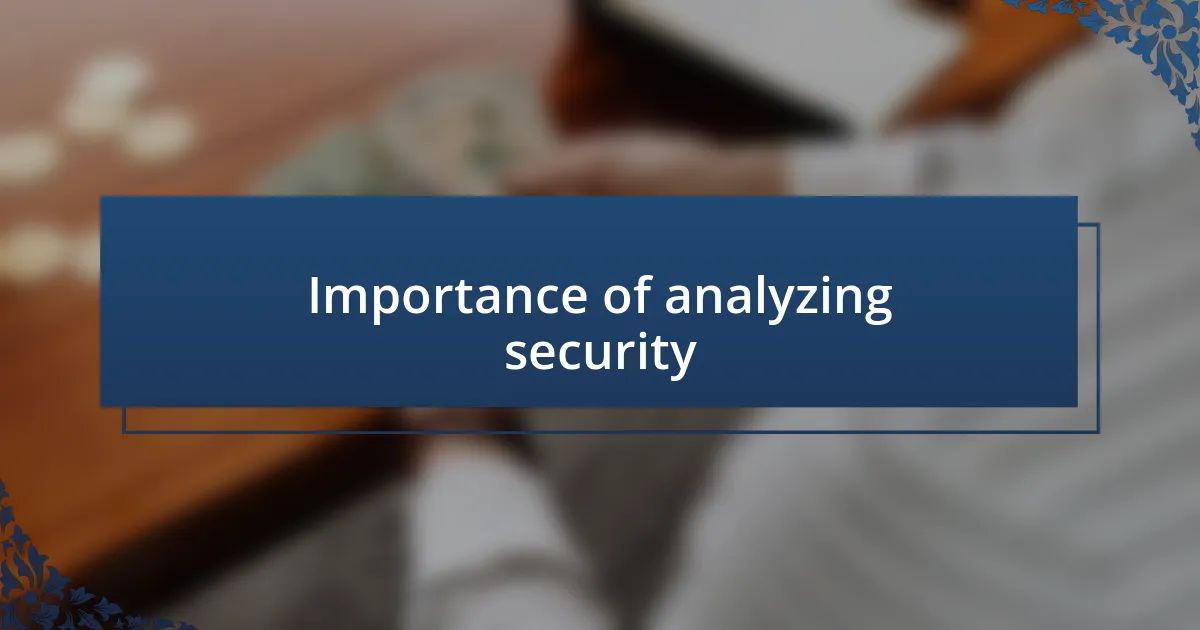
Importance of analyzing security
The significance of analyzing security cannot be overstated. Throughout my career, I often thought about the countless hours developers and security teams invest into creating robust systems. Yet, it’s the analysis phase that separates effective protocols from ineffective ones. This continuous evaluation helps in identifying vulnerabilities that may not be apparent during the initial design.
There was a point when I witnessed a company suffer a major data breach due to outdated security protocols. It was a stark reminder of how swiftly a single oversight can lead to catastrophic consequences. Analyzing security allows organizations to adapt to emerging threats, ensuring that they are always a step ahead. I’ve seen firsthand the peace of mind that comes from knowing that a thorough analysis can fortify defenses against a barrage of ever-evolving cyber threats.
In my experience, regular security assessments foster a culture of vigilance and accountability. When teams prioritize this practice, they cultivate not just expertise but also a proactive stance toward potential issues. These assessments often reveal gaps that can be addressed, reinforcing the idea that security is an ongoing journey rather than a final destination.
| Benefits of Analyzing Security | Real-life Implications |
|---|---|
| Identifies Vulnerabilities | Prevents Data Breaches |
| Adapts to New Threats | Maintains Trust with Users |
| Enhances Overall Security | Promotes Safety Culture |
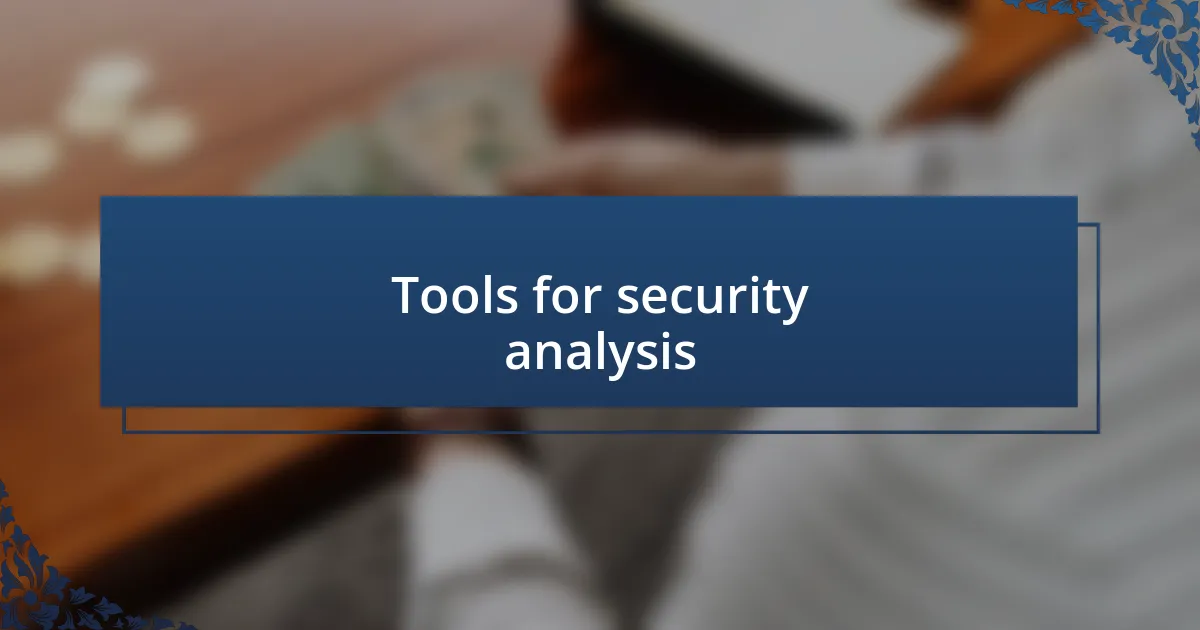
Tools for security analysis
When it comes to analyzing security protocols, having the right tools at your disposal makes all the difference. Over the years, I’ve experimented with various software and platforms, each offering unique features that cater to different aspects of security analysis. A tool that resonates with me is the open-source framework, OWASP ZAP, which I’ve often used for vulnerability scanning. It’s user-friendly and surprisingly effective for identifying weaknesses in web applications. My first encounter with it was during a critical project, and I was amazed at how quickly it highlighted issues that we hadn’t even considered.
Here are some key tools I often rely on for thorough security analysis:
- Burp Suite: An indispensable tool for web application security testing.
- Wireshark: Excellent for analyzing network protocols and troubleshooting issues.
- Nessus: A widely-used vulnerability scanner providing detailed reports of potential risks.
- Metasploit: Essential for penetration testing, allowing simulation of real attacks to identify flaws.
- Nmap: Effective for network discovery and security auditing.
Utilizing these tools not only streamlines the analysis process, but they also empower security teams to dive deeper into their defenses. I’ve found that integrating such tools into my workflow fosters a collaborative environment where team members can learn from each analysis, sharing insights and refining our approach to security.
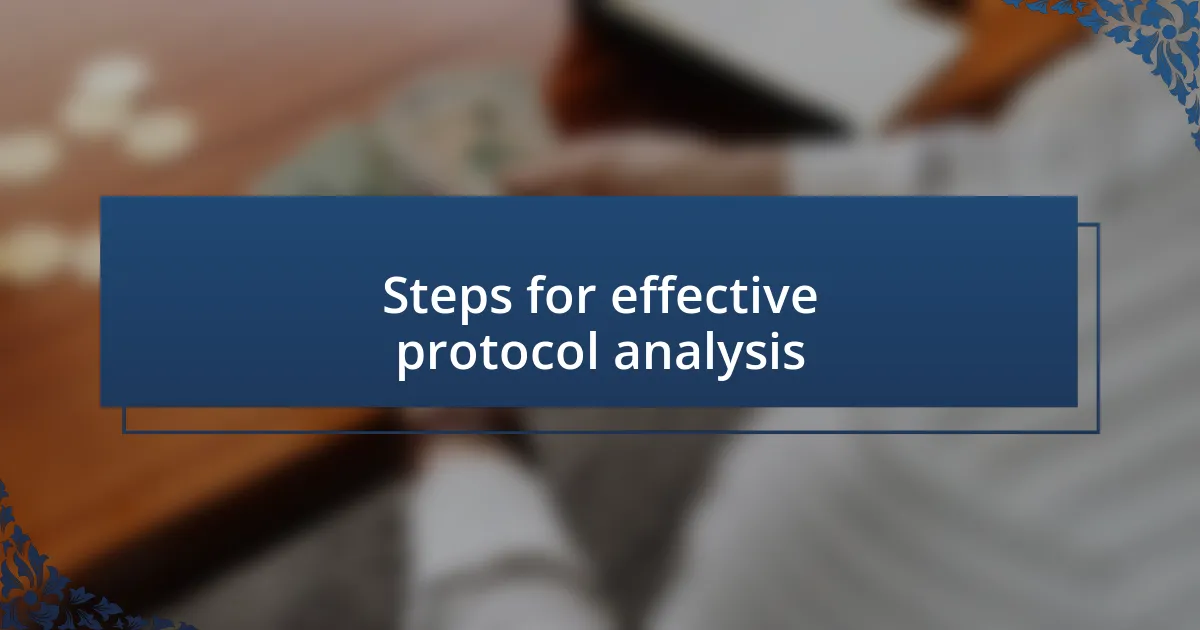
Steps for effective protocol analysis
Effective protocol analysis begins with a clear understanding of the protocols in question. When I first approached this type of analysis, I quickly realized that familiarity with the underlying technology is crucial. I remember feeling overwhelmed by the complexities of certain protocols, but breaking them down into smaller components not only simplified the process but also enhanced my confidence in identifying potential vulnerabilities.
Next, I recommend establishing a systematic approach to your analysis. By creating a checklist that covers various aspects—such as authentication mechanisms, data integrity methods, and encryption types—you can ensure that no stone is left unturned. I recall one project where employing a detailed analysis checklist revealed a significant oversight in data transmission security. That moment taught me how vital it is to remain thorough and methodical.
Lastly, collaboration is key in protocol analysis. Engaging with colleagues to obtain diverse perspectives has been one of the most rewarding aspects of my work. One instance that stands out is when we hosted a brainstorming session that led to a breakthrough in understanding a complicated protocol’s vulnerabilities. Have you ever experienced a similar “aha” moment with a team? I can attest to the power of shared insights in honing our analytical capabilities, making our analysis not just effective but truly comprehensive.
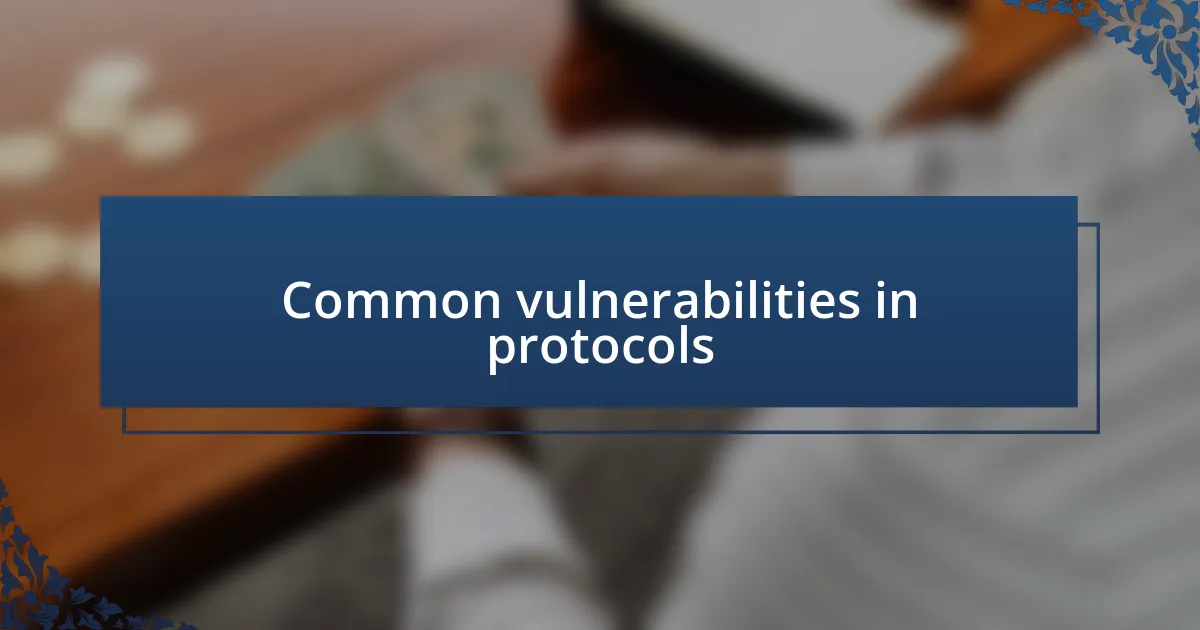
Common vulnerabilities in protocols
When I examine security protocols, I often find that common vulnerabilities lurk behind inadequate authentication mechanisms. For instance, there was a project where a weak password policy allowed unauthorized access to sensitive information. It made me wonder: how many organizations are still neglecting to enforce strong authentication despite knowing the risks?
Moreover, I frequently encounter encryption flaws that create exploitable backdoors. I recall investigating a protocol that used outdated encryption algorithms, which left the data exposed to interception. That experience reinforced my belief that staying up-to-date with cryptographic advancements is non-negotiable for any security protocol.
Another significant vulnerability I’ve noticed relates to improper error handling. I remember analyzing a system that leaked sensitive information through error messages, making it easy for attackers to piece together potential exploits. It raises an important question: how often do we consider the unintended consequences of seemingly minor implementation details? These small gaps can have profound implications for overall security.

Best practices for securing protocols
When it comes to securing protocols, enforcing strong authentication is at the top of my list. I remember a project where a lack of multi-factor authentication left the door wide open for intruders, leading to a significant breach. Seeing firsthand the ramifications of such a basic oversight really drives home the importance of implementing robust security measures from the outset.
Staying current with encryption standards is another best practice that I advocate for tirelessly. I once worked on a system upgrade where we replaced a decade-old encryption protocol with the latest algorithms. The improvement not only boosted security but also enhanced user trust, reminding me that investing in modern encryption isn’t just about protection; it’s about fostering confidence in your systems.
I have also found that regular audits and updates play a crucial role in protocol security. Reflecting on an instance where we discovered outdated software during an audit, I realized that these checks are integral to identifying vulnerabilities before they can be exploited. How often do we pause to consider that maintaining security is an ongoing process rather than a one-time effort? It’s a vital mindset for any organization aiming for true resilience against potential threats.

Case studies of protocol analysis
Analyzing security protocols through case studies can reveal astonishing insights. For instance, I once dove into a renowned banking system breach where the underlying protocol had overlooked essential session-handling mechanisms. The aftermath was chaotic. Customers lost trust, and the company faced steep financial penalties. This experience highlighted how even minor details in protocol design can lead to significant repercussions.
In another instance, I examined the wireless security protocols of a smart home device manufacturer. Their reliance on outdated protocols made them vulnerable to various attacks. After demonstrating how easy it was to exploit these weaknesses, I felt compelled to share my findings with their team. It was rewarding to see them take the lessons to heart and implement necessary updates, showcasing the tangible impact that detailed protocol analysis can have on real-world applications.
Reflecting on these case studies, I often wonder how many organizations overlook the necessity of thorough protocol analysis. It’s more than just a technical exercise; it’s about safeguarding customer trust and ensuring the longevity of a service. Each analysis not only serves as a learning tool for the organization but also reinforces the idea that staying ahead of potential vulnerabilities is paramount in today’s digital landscape.

